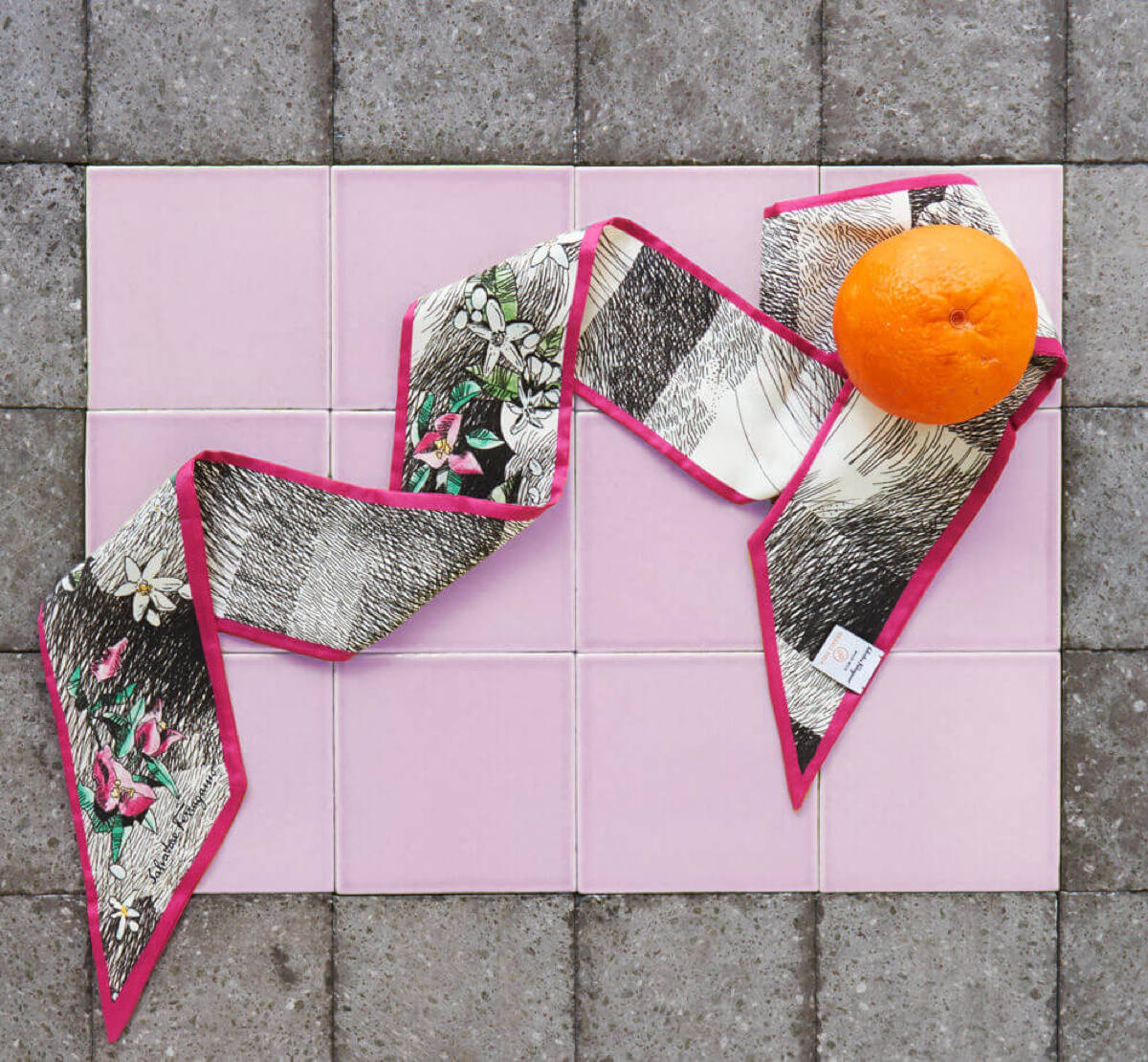
Round-up: 8 Sustainable Fashion Textiles
Insects, fruits, wine, cow dung, coffee and DNA – sounds like a pretty odd list of things, doesn’t it? You’d be surprised to find that all of the natural resources mentioned here have something in common… They are all potential solutions for a more sustainable & circular fashion industry, and a better tomorrow. With conscious collaborations to bridge the gap between fashion & other industries such as food, each of these materials can be used to produce eco-friendly fibres that have a low carbon footprint!
Currently, more than 60% of the clothing in our industry is made up of polyester with toxic processes, and according to the World Bank, 20% of water pollution results from textile processing. Cotton and leather are two of the dirtiest materials in our wardrobes, using a vast range of pesticides, water & energy in production – so it’s only crucial for us to innovate to pave way for a more socially responsible industry. Read on to learn more about the top 8 ethical textiles and low-impact alternatives to silk, leather, wool, cotton & more.
SUSTAINABLE FASHION AND TEXTILES
Microsilk
Made of: Spider Webs
Launched by: Bolt Threads
Unique features: Durable, water-resistant & renewable
Used by: Stella McCartney, Adidas, North Face…
Did you know that the silk strings in a spider web are five times stronger than steel and have more elasticity than rubber bands? With such strength & flexibility, it’s no surprise that Bolt Threads took the leap in making the textile commercially viable with a relatively simple process. Through bio-genetic engineering, the yeast of spider webs is used to produce large amounts of silk proteins through a fermentation process which uses water & sugar. The raw liquid silk is then spun into fibres and weaved into garments. Without the use of polyester & toxic processes, this spider silk is renewable and completely sustainable. Who would’ve ever thought that these creepy crawlies would be of good use to the fashion industry?
Orange Silk
Made of: Orange Peels
Launched by: Orange Fibre
Unique Features: Soft, multi-purpose, renewable
Used by: Salvatore Ferragamo
Have you ever thought about what happens to the orange peels that are left over from your juice? More than 700,000 tonnes of citrus by-products are produced and wasted every year in Italy alone – giving the Italian based company, Orange Fibre, an opportunity to turn this waste into a natural fibre with a low carbon footprint. Similarly to Bolt Threads, the process extracts the citrus cellulose from these leftover orange peels and spins it into a fibre; resulting in a refined and high-quality fabric. By bringing the two pillars of Italian heritage together (fashion & food), Orange Fibres has developed a silk-like cellulose yarn that can be blended with other materials to create orange twill, poplin, jersey & more, raising the standards of modern textile production.

Polylana
Made of: Recycled Textiles
Launched by: Polylana
Unique Features: Low-impact, easy to blend
Used by: Calvin Klein, Forever 21…
As of today, Polylana has saved 46,440,000 litres of water – a figure which is equivalent to 18 olympic sized swimming pools. The company introduced a low-impact alternative to acrylic or wool fibres made from a mixture of virgin and recycled materials by using 85% less water, 76% less waste and 19% less CO2 in their production processes. According to the company, “to enhance sustainability, functionality and/or aesthetics, Polylana fibre can be spun with Lenzing EcoVero, Organic Cotton, Recycled Wool, Nylon, Merino or Cashmere.” The textile also releases 32% less synthetic microplastic fibres from domestic washing machines and ensures reduced plastic pollution in our environment.
Remeant
Made of: Single use plastic
Launched by: Remeant
REMEANT is a high quality, colorful innovative textile made from single use plastic. REMEANT, specialised on sustainable fashion and textiles, transforms tons of different plastics that are discarded, piling up in landfills and polluting the oceans and turns them into fabulous textiles. “We are highly passionate about creating patent-pending fabrics from non-recycled and unconventional materials such as Bubble wrap, aluminum and other industrial waste that is being collect from factories.” – they say.
Piñatex
Made of: Pineapple Leaves
Launched by: Ananas Anam
Unique Features: Ethical, vegan, resilient
Used by: Hugo Boss, Maniwala, Trussardi, Bourgeois Boheme…
We all know the environmental impact of mass leather production, including processes of chemical tanning that end up polluting the air and water of villages and towns. Due to this reason alone, Carmen, a leathergoods expert decided on a trip to the Philippines that a sustainable alternative had to be introduced. So after seven years of research & development, she created a non-woven leather textile with the use of pineapple leaves – another byproduct of agricultural waste.
Her company, Ananas Anam, developed the first automated machine to assist with the process of decortication, which extracts the long fibres from the leaves that turn into a mesh, which is then transported to Spain for finishing touches, giving Piñatex its leather-like appearance. The sustainably-sourced & cruelty-free textile is now used in clothing, footwear, fashion accessories and furnishings – with a low environmental impact and high social responsibility.

Tencel
Made of: Wood pulp
Launched by: Lenzing
Unique Features: Moisture absorbent, antibacterial, biodegradable
Used by: Levis, Reformation, Athleta, Marks & Spencers
Produced by Austrian based company Lenzing, Tencel is a light and versatile fabric made by Lyocell (rayon), a cellulose fibre developed by dissolving wood pulp which is sourced from sustainably managed eucalyptus plantations. It’s use has become quite popular due to its breathability, moisture-absorbency, thermal regulation and antibacterial properties. It is now used in activewear, denim, intimates, home furnishings & more through a sustainable, closed-loop production as it uses much less energy and water than conventional cotton has a low ecological impact.

Zoa
Made of: Bio-fabricated DNA
Launched by: Modern Meadow
Unique Features: Ethical, cruelty-free,
Used by: To be unveiled in 2019
There’s no shortage of sustainable leather alternatives with the numerous innovative solutions led by fruit waste (pineapples, bananas, apples, grapes & more), but when it comes to taking the cruelty component out of the leather industry – there’s one company in particular that has the spotlight. Modern Meadow uses lab-grown cells that are fermented and multiplied into collagen proteins to assemble into animal-free, man-made leather which looks and feels exactly like animal leather. The Zoa leather can withstand any density, shape, texture & is highly adaptable into various uses. The same technology and innovation is being applied into the food industry to create plant-based meats – but while the latter is already being mass-produced and consumed, the bio-fabricated leather is yet to be used by modern fashion brands.
S.Cafe
Made of: Coffee grounds
Launched by: Singtex
Unique Features: Deodorizing, fast-drying, UV-resistant
Used by: Nike, Adidas, Nautica…
A majority of us can’t go on about our day without a cup of coffee in the morning – which requires 140 litres of water to produce and wastes 90% of the coffee bean. Made from this coffee ground waste and plastic bottles, Taiwanese based company Yingtex innovated an eco-friendly yarn in 2008 which now has over 110 clients, including Patagonia, Timberland, American Eagle and Victoria’s Secret to name a few. Three cups of coffee grounds and five recycled plastic bottles have the capability to produce one t-shirt in the S.Cafe fibre. The best part is that the coffee waste is sourced from cafes and stores in Taiwan, including Starbucks!

Mestic
Made of: Cow dung
Launched by: Inspidere
Unique features: Energy efficient, renewable, odourless*
Supported by: H&M Foundation
If you think the textiles mentioned above are unusual, you clearly haven’t heard of Mestic yet. Excessive cow dung from intensive dairy farming has led to an over-saturation of the soil in various European countries. This is why Dutch designer Jalila Essaïdi proposed to make the industry more circular by using the manure from cattle to produce bioplastic and sustainable fibres, a method known as Mestic. Manure from these cows are made up of 35% cellulose, so with the global quantities of excess manure, there would be enough cellulose to meet the demand for fibres and replace cotton, which is currently a crop with the highest carbon footprint.
+ Words: Mashal Mush








